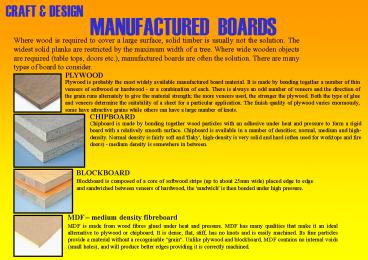MANUFACTURED BOARDS - PowerPoint PPT Presentation
1 / 1
Title:
MANUFACTURED BOARDS
Description:
MDF is made from wood fibres glued under heat and pressure. MDF has many qualities that make it an ideal alternative to plywood or chipboard. ... – PowerPoint PPT presentation
Number of Views:737
Avg rating:5.0/5.0
Title: MANUFACTURED BOARDS
1
MANUFACTURED BOARDS
Where wood is required to cover a large surface,
solid timber is usually not the solution. The
widest solid planks are restricted by the maximum
width of a tree. Where wide wooden objects are
required (table tops, doors etc.), manufactured
boards are often the solution. There are many
types of board to consider.
PLYWOOD
Plywood is probably the most widely available
manufactured board material. It is made by
bonding together a number of thin veneers of
softwood or hardwood - or a combination of each.
There is always an odd number of veneers and the
direction of the grain runs alternately to give
the material strength the more veneers used, the
stronger the plywood. Both the type of glue and
veneers determine the suitability of a sheet for
a particular application. The finish quality of
plywood varies enormously, some have attractive
grains while others can have a large number of
knots.
CHIPBOARD
Chipboard is made by bonding together wood
particles with an adhesive under heat and
pressure to form a rigid board with a relatively
smooth surface. Chipboard is available in a
number of densities normal, medium and
high-density. Normal density is fairly soft and
'flaky', high-density is very solid and hard
(often used for worktops and fire doors) - medium
density is somewhere in between.
BLOCKBOARD
Blockboard is composed of a core of softwood
strips (up to about 25mm wide) placed edge to
edge and sandwiched between veneers of hardwood,
the 'sandwich' is then bonded under high
pressure.
MDF medium density fibreboard
MDF is made from wood fibres glued under heat and
pressure. MDF has many qualities that make it an
ideal alternative to plywood or chipboard. It is
dense, flat, stiff, has no knots and is easily
machined. Its fine particles provide a material
without a recognisable "grain". Unlike plywood
and blockboard, MDF contains no internal voids
(small holes), and will produce better edges
providing it is correctly machined.































